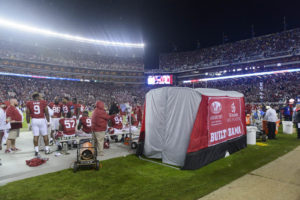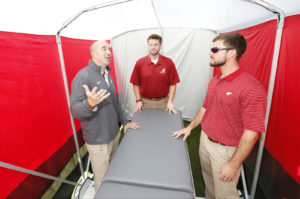
When an athlete is injured on the field, it’s critical that medical professionals evaluate him or her right away. At a football game or other arena sport, distractions and confusion can inhibit a quick, efficient diagnosis.
Engineering students at the University of Alabama devised a solution: They designed a collapsible tent that can be set up on the sidelines of a football field or other arena to be used for medical treatment.
The tent remains collapsed on the ground for the game—out of the sightline of fans—unless it is needed. One person can deploy it in less than 10 seconds, quickly providing a private, confidential space for treatment.
The development of the tent became a university project. Jeff Allen, director of sports medicine for the school’s Crimson Tide Athletics, had the idea and took it to Dr. Charles L. Karr, dean of the College of Engineering. He enlisted four mechanical engineering students, who designed and fabricated the tent as their senior design project.

Tide football. Photo: Robert Sutton, University of Alabama.
The students’ design connects the structure of the tent to a central hub. When raised, it fans over an exam table. The table secures the structure to the ground, allowing it to be used on a variety of surfaces including grass, artificial turf and concrete without the use of guidelines. The surface area that touches the ground is covered with heavy-grade ballistic nylon and the doors close with magnets. Made of a synthetic fabric chosen for ventilation, the tent’s light gray roof lets in enough light to allow an exam to be conducted.
The tent’s manufactured components were donated by Altec Industries of Birmingham, Ala., and supplies for the prototype were donated by CAVCO of Childersburg, Ala.
 TEXTILES.ORG
TEXTILES.ORG


